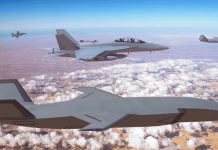A video of Japan’s largest warship, ‘Izumo,’ which appeared to be recorded overhead from a drone, surfaced on Chinese social media. Previously believed to be generated using artificial intelligence (AI), it is now confirmed to have been shot using a UAV.
The Japanese Ministry of Defense (MoD) stated on May 9 that there was a good chance that a drone flew illegally over Yokosuka Naval Base to record the widely-shared video of Japan’s largest destroyer. When the video first appeared in late March, the authorities dismissed it as fabricated.
However, an investigation was launched considering the seriousness of the situation. The Ministry officials have confirmed that the investigation (of the video) was carried out by examining the surrounding flora and buildings.
“The incident could cause a serious problem for the defense of our country,” Defense Minister Minoru Kihara told a news conference on May 10. “We take it extremely seriously.”
A 20-second overhead footage of the Maritime Self-Defense Force (SDF) destroyer, Izumo, stationed at Yokosuka Naval Base in Kanagawa Prefecture, was uploaded on March 26 on the Chinese video-sharing website Bilibili. The ship’s deck can be seen in the video as the camera gently glides from the stern to the bow. The drone must have been flying at a very low altitude.
There is a small scandal in Japan.
A drone launched by a Chinese citizen flew over the deck of the helicopter carrier JS Izumo DDH183 of the Japan Maritime Self-Defense Force in Yokosuka. pic.twitter.com/gOd6oI7vJg
— Clash Report (@clashreport) March 30, 2024
Soon after it appeared on Chinese social media, the English, Japanese, and Chinese versions of the video went viral on X. At that time, military observers attributed the footage to being shot from a Chinese civilian drone. However, the Japanese Ministry of Defense remained tight-lipped about its origin.
When probed about the video, Chinese Foreign Ministry spokesman Lin Jian told a news conference on May 9, “I don’t know where the footage you mentioned came from.”
It is against the law in Japan to fly drones above SDF sites and their environs without permission. The Yokosuka Naval Base is one of the designated facilities where drone detection equipment is used.
In the aftermath of the incident, which has taken the Japanese government by storm, Kihara announced that the ministry intended to deploy jamming technology to force (unauthorized) drone landings. Japan also aims to install more sophisticated equipment to counter drones that are difficult to detect.
While the origin of the drone remains unknown, Chinese civilian drones are notorious for flying over military facilities in Taiwan.

Chinese Drones Are Flying Over Taiwan, Too
Last month, for instance, footage of Taiwanese soldiers walking around the Kinmen Islands was allegedly shot by civilian drones that flew inside Taiwanese territory from China.
These were published by bloggers on the Chinese social network. This was reportedly one of many instances where Chinese drones were allegedly deployed to eavesdrop on military sites in Taiwan.
Several military analysts on both sides expressed shock and wondered whether keeping an eye on Taiwan’s military had become that simple for Chinese authorities. China frequently uses both military and civilian drones to fly near Taiwanese islands.
More drones have been spotted spying on Taiwan's military bases on its outlying Kinmen Islands. pic.twitter.com/eOk7VEY7xD
— TaiwanPlus News (@taiwanplusnews) April 9, 2024
Earlier, Chen Kuo-Ming of Defense International Magazine told Taiwan Plus: “All countries are the same. Whether it’s an airport or a base, all of them need special radars to intercept these small drones. This should serve as a lesson to the military. Technology is central to keeping up with the times.”
Earlier in March, a China People’s Liberation Army (PLA) WZ-7 high-altitude long-endurance UAV was spotted over the Sea of Japan. The event marked the first sighting of a WZ-7 by Japanese authorities, heightening concerns in the strategically significant waterbody situated between Japan’s home islands and mainland East Asia.
First report of WZ-7 over the Sea of Japan, supposedly from the 48th Regiment of the 16th Special Aircraft Division of NTC in Shuangliao. I'm curious about its flight path, although Shuangliao is about 600 km from the Sea of Japan, it can only pass through NK🇰🇵 or RU🇷🇺 airspace. pic.twitter.com/4dao6snrMg
— Q (@foolsball) March 26, 2024
The Japanese MoD released a statement announcing that it had to dispatch fighter jets in response to the presence of the Chinese drone. However, according to the MoD, the Chinese drone did not breach Japanese territorial airspace.
With a growing number of Chinese UAVs in the region, Japan is believed to be keeping a close eye on the situation amid concerns that the Chinese military may be extending the operating range of its drones for snooping.
- Contact the author at sakshi.tiwari9555 (at) gmail.com
- Follow EurAsian Times on Google News




